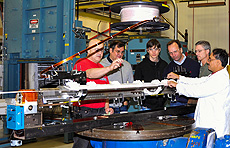Small but powerful
 |
Members of the CERN-Fermilab team wind the magnet coil. From left to right: M. Whitson, A. Zlobin, B. Auchmann, M. Karppinen, F. Nobrega and J. Alvarez. A. Zlobin (Fermilab) and M. Karppinen (CERN) are the technical heads of the 11 T Collaboration. Photo: CERN |
Magnet size is crucial to an accelerator as it determines the final circumference and power. This spring, Fermilab unveiled a 10.4-Tesla magnet that is shorter than the 8-Tesla magnets currently installed in the LHC. These new magnets will be a valuable asset to the HL-LHC, the next step of the LHC machine.
The HL-LHC (High Luminosity LHC) represents the future of CERN's flagship accelerator. From around 2020, this major upgrade will allow a substantial increase in the rate of collisions compared to today. The project poses various technical challenges, some of which appear to be close to being resolved.
The success of the HL-LHC hinges on two essential conditions: the installation of more powerful magnets to guide the beams and the addition of extra collimators to mitigate the increase in radiation. However, one of the key questions is how to insert additional collimators in a 27-km ring already full to bursting. The answer is to replace the current magnets by shorter but more powerful magnets, which is what Fermilab's engineers have been working on in collaboration with CERN.
"The idea originated from a proposal made by Lucio Rossi, the head of CERN's Magnets, Superconductors and Cryostats group, in 2010," explains Giorgio Apollinari, head of Fermilab's Technical Division. "During a discussion he suggested replacing a few of the LHC's 8-Tesla dipole magnets with shorter 11-Tesla magnets. His idea aligned well with the goals of Fermilab's R&D programme for projects including the muon collider, so we decided to collaborate."
It was not long before the decision started to pay off. In spring 2012, only 20 months after the research had begun, Fermilab unveiled a 10.4-Tesla two-metre-long prototype magnet. Once several more development phases have been completed, an 11-metre-long magnet should see the light of day. Nothing short of a revolution when you think that the existing magnets are 14 metres long.
"We achieved this using niobium-tin (Nb3Sn) instead of niobium-titanium (NbTi), which was the material used in the manufacture of the superconducting cables of the LHC magnets in the 1990s," adds Giorgio Apollinari.
Looking at what the CERN-Fermilab collaboration has achieved in less than two years, we think it's safe to assume that 11-Tesla magnets are not far off…
Read more
—Anaïs Schaeffer
|